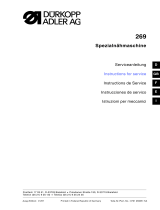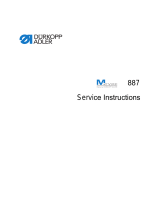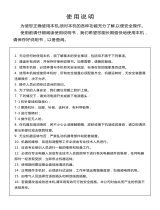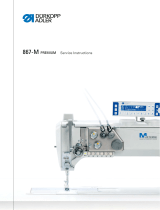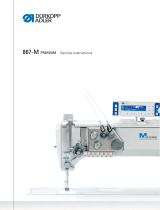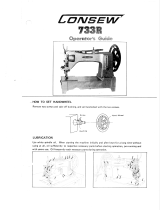Page is loading ...

69-373 / 69-373H
Spezialnaehmaschine
Serviceanleitung
Service Instructions
Manufacturer: Dürkopp Adler Manufacturing (Shanghai) Co., Ltd.
1201 Luoshan Road, Pudong New Area, Shanghai 200135, China
Contact: Dürkopp Adler AG, PO Box 17 03 51, D-33703 Bielefeld, Potsdamerstr. 190, D-33719 Bielefeld,
Phone +49 (0) 521 9 25 00, Fax +49 (0) 521 9 25 24 35, www.duerkopp-adler.com
Manufacturer: Dürkopp Adler Manufacturing (Shanghai) Co., Ltd.
1201 Luoshan Road, Pudong New Area, Shanghai 200135, China
Contact: Dürkopp Adler AG, PO Box 17 03 51, D-33703 Bielefeld, Potsdamerstr. 190, D-33719 Bielefeld,
Phone +49 (0) 521 9 25 00, Fax +49 (0) 521 9 25 24 35, www.duerkopp-adler.com
Ausgabe / Edition: Änderungsindex Teile-Nr./Part.-No.:
02/2008 Rev. index: 00.0 PrintedinChina 0791 069642
D
GB

Alle Rechte vorbehalten.
Eigentum der Dürkopp Adler AG und urheberrechtlich geschützt. Jede, auch auszugsweise Wiederverwendung
dieser Inhalte ist ohne vorheriges schriftliches Einverständnis der Dürkopp Adler AG verboten.
All rights reserved.
Property of Dürkopp Adler AG and copyrighted. Reproduction or publication of the content in any manner, even
in extracts, without prior written permission of Dürkopp Adler AG, is prohibited.
Copyright ©
Dürkopp Adler AG - 2008

General safety instructions
The non-observance of the following safety instructions can cause
bodily injuries or damages to the machine.
1. The machine must only be commissioned in full knowledge of the
instruction book and operated by persons with appropriate training.
2. Before putting into service also read the safety rules and
instructions of the motor supplier.
3. The machine must be used only for the purpose intended. Use of
the machine without the safety devices is not permitted. Observe all
the relevant safety regulations.
4. When gauge parts are exchanged (e.g. needle, presser foot, needle
plate, feed dog and bobbin) when threading, when the workplace is
left, and during service work, the machine must be disconnected
from the mains by switching off the master switch or disconnecting
the mains plug.
5. Daily servicing work must be carried out only by appropriately
trained persons.
6. Repairs, conversion and special maintenance work must only be
carried out by technicians or persons with appropriate training.
7. For service or repair work on pneumatic systems, disconnect the
machine from the compressed air supply system (max. 7-10 bar).
Before disconnecting, reduce the pressure of the maintenance unit.
Exceptions to this are only adjustments and functions checks made
by appropriately trained technicians.
8. Work on the electrical equipment must be carried out only by
electricians or appropriately trained persons.
9. Work on parts and systems under electric current is not permitted,
except as specified in regulations DIN VDE 0105.
10. Conversion or changes to the machine must be authorized by us
and made only in adherence to all safety regulations.
11. For repairs, only replacement parts approved by us must be used.
12. Commissioning of the sewing head is prohibited until such time as
the entire sewing unit is found to comply with EC directives.
13. The line cord should be equipped with a country-specific mains
plug. This work must be carried out by appropriately trained
technicians (see paragraph 8).
It is absolutely necessary to respect the safety
instructions marked by these signs.
Danger of bodily injuries !
Please note also the general safety instructions.


Contents Page:
Service Instructions Cl. 69-373
(Edition 02/2008) Cl. 69-373H
1. General
1.1 Gauge set ................................................... 4
2. Zero position, feeding with sewing equipment
2.1 Checking the zero position (position of the stitch regulator link)................... 5
2.2 Settingofthebottomfeed.......................................... 6
2.2.1 Positionofthefeeddoginthethroatplatecutout ........................... 6
2.2.2 Advancingmovementofthefeeddog................................... 7
2.2.3 Lifting movement of the feed dog (only with the class 69-373H) ................... 8
2.3 Synchronous run of the needle and bottom feed ............................ 10
2.4 Setting of the upper feed .......................................... 11
2.4.1 Stroke of the upper feed and the material presser foot......................... 11
2.4.2 Advancing movement of the upper feed foot............................... 12
2.5 Stitch regulator (equal stitch length for forward and reverse stitching) ............... 13
3. Sewing foot height and sewing foot lifting
3.1 Sewingfootliftingwiththeliftinglever.................................. 14
3.2 Sewingfootliftingwiththekneelever................................... 15
4. Opening the thread tension
4.1 Threadcontrollerspring........................................... 17
5. Needle bar height .............................................. 18
6. Hook settings
6.1 Loop stroke and clearance of the hook point to the needle ...................... 19
6.2 Bobbin case holder.............................................. 20
7. Bobbin winder ................................................ 21
8. Oil lubrication
8.1 General..................................................... 22
8.2 Lubrication points............................................... 23
9. Maintenance ................................................. 24
10. Summary of all sewing machine settings ............................... 25
GB


1. General
These service instructions describe the adjustments that can be made
to the class 69 special sewing machine.
69-373 Single-needle, lockstitch, free-arm sewing machine with
bottom feed, needle feed and alternating top feed.
69-373-H like the class 69-373,
additionally with bottom feed stroke.
ATTENTION!
The tasks described in the present service instructions may only be
carried out by qualified staff or other appropriately trained persons!
Caution: Danger of injury!
Always turn off the main switch before any repair, conversion and
maintenance work and separate the machine from the pneumatic
supply line.
Any adjustment work and function testing with the machine running is to
be conducted only under observance of all safety measures and with
the greatest possible caution.
The present service instructions describe the setting of the sewing
machine in a logical order.
Please remember that various setting positions are dependent on each
other. Thus it is essential that the settings be made in the order
described.
For all adjustments of parts involved in the stitch formation, a new
undamaged needle must be inserted.
When adjusting the cutting devices all the cutting tools must also be
replaced.
ATTENTION!
All parts marked with colors were set at the factory and should only be
loosened by skilled personnel.
3
GB

1.1 Gauge set
You can use the setting gauges included in the gauge set to check and
adjust accurately the sewing machine.
Pos. Setting gauge Order no. Use
1 Gauge 0981 150003 Loop stroke
2 Block 0981 150002 Loop stroke
3 Special wrench 0981 160402 Stitch uniformity
4
3
1
2

2. Zero position, feeding with sewing equipment
2.1 Checking the zero position (position of the stitch regulator link)
Caution: Danger of injury!
Turn off the main switch.
Check the zero position of the stitch regulator only when the sewing
machine is switched off.
Rule and control
In the zero position of the stitch regulator lever, the feed dog and the
needle should not make any advancing motion when the handwheel is
moved.
–
Set the stitch regulator lever 3 to “0”.
Loosen the butterfly nut 1.
Turn the adjusting screw 2.
Tighten the butterfly nut 1.
–
Turn the handwheel.
The needle and feed dog should not make any advancing motion.
5
GB
1
2
3

2.2 Setting of the bottom feed
2.2.1 Position of the feed dog in the throat plate cutout
Caution: Danger of injury!
Turn off the main switch.
Check and set the position of the feed dog only when the sewing
machine is switched off.
Rule and control
Sideways:
The feed dog must lie centric in the throat plate cutout.
In the feeding direction:
At the maximum stitch length, the minimum clearance of the feed
dog to the front and rear edges of the throat plate cutout must be
approx. 0.5 mm.
The clearance is required so that the feed dog does not hit against the
throat plate during sewing.
–
Set the stitch regulator lever to “max.”
–
Turn the handwheel and check the position of the feed dog.
Adjustment
Sideways:
–
Loosen screws 1.
–
Slide the feed dog axially until it lies centric in the throat plate
cutout.
–
Tighten screws 1 again.
In the feeding direction:
–
Tilt back the machine head.
–
Loosen the threaded pin 3 on the fork.
–
Push the feed dog lever 2 forward (to the operator side), with the
feed dog screwed on, until a clearance of 0.5 mm is obtained.
–
Tighten the threaded pin 3 again.
6
3
12
0,5 mm

2.2.2 Advancing movement of the feed dog
Caution: Danger of injury!
Turn off the main switch.
Check and set the advancing movement of the feed dog only when the
sewing machine is switched off.
Rule and control
When the stitch regulator lever is operated and set to have the greatest
sewing length, both the needle and the feed dog should not move.
–
Set the stitch regulator lever to “max.”.
–
Bring the needle bar 1 to the loop stroke position.
Turn the handwheel to put the needle bar into its lowest position.
Fix the loop stroke gauge 2 with the block 3 against the needle bar
rocker.
Tighten the screw of the block 3.
Pull out the loop stroke gauge2.
Turn the handwheel until the block 3 lays onto the needle bar
rocker.
–
Move the stitch regulator lever up and down.
During this movement, both the needle and the feed dog should not
move.
Adjustment
–
Loosen screws 4 and 6.
–
Turn thrust cam 5 on the shaft until the zero position of the feed dog
and the needle is reached.
–
Align the thrust cam 5 axially on the shaft.
The fork 7 must lie centric to the run surface of the cam sliding ring.
–
Tighten screws 4 and 6 again.
–
Remove the block 3.
7
GB
4
5
6
7
1
2
3
2
m
m

2.2.3 Lifting movement of the feed dog (only with the class 69-373H)
Caution: Danger of injury!
Turn off the main switch.
Check and set the lifting movement of the feed dog only when the
sewing machine is switched off.
Rule and control
In loop stroke position the marking 2 on the toothed wheel 1 should
point to the top.
–
Lift the sewing feet 3.
–
Pull off the cover 6 to the left.
–
Unscrew the cover plate 4.
–
Remove the throat plate 5 and upper feed foot.
–
Remove the upper feed food holder 7.
–
Remove the pin 8.
–
Unscrew the bed plate 9.
–
Unscrew the hook 10.
8
321
65 4
8
7
9
10

GB
–
Unscrew screws 13.
–
Remove the cover 12 and the dirt wiper 11.
The toothed belt 1 is now accessible.
–
Bring the machine into loop stroke position (see chapter 2.2.2).
–
Pull off the toothed wheel 1 and put it on again so that the marking
2 points to the top.
Reassembling
–
Reassemble the machine again in inverted sequence.
–
Set the hook as described in chapter 6.
9
321
13 12 11

2.3 Synchronous run of the needle and bottom feed
Caution: Danger of injury!
Turn off the main switch.
Check and set the synchronous run only when the sewing machine is
switched off.
Rule and control
The needle must penetrate the middle of the needle hole.
–
Turn the handwheel in the sense of direction and check the
penetration of the needle into the needle hole.
Adjustment
–
Screw off the arm cover.
–
Loosen screw 2.
–
Align the needle bar with the rocker 1.
–
Tighten screw 2 again.
–
Screw on the arm cover again.
10
2
1

2.4 Setting of the upper feed
2.4.1 Stroke of the upper feed and the material presser foot
Caution: Danger of injury!
Turn off the main switch.
Check and set the stroke of the upper feed and the material presser
foot only when the sewing machine is switched off.
Rule and control
The stroke of material presser foot and upper feed should be equal.
–
Check the stroke of the upper feed and material presser foot
through turning the handwheel.
In the highest position, both of them should have the same clearance to
the throat plate.
Adjustment
–
Loosen screw 1.
–
Turn the upper feed lever 2 on the shaft.
To the rear = increase the stroke of the upper feed foot
To the front = decrease the stroke of the upper feed foot
–
Tighten the screw 1 again.
Hint
Once the stroke of the upper feed foot is correct, the material presser
foot setting will also be correct.
Both movements are executed by the same cam.
11
GB
1
2

2.4.2 Advancing movement of the upper feed foot
Caution: Danger of injury!
Turn off the main switch.
Check and set the advancing movement of the upper feed foot
only when the sewing machine is switched off.
Rule and control
The upper feed foot should reach the top edge of the feed dog at the
same time as the descending needle.
–
Check the movement of the upper feed foot by turning the
handwheel.
Adjustment
–
Loosen screws 1 and 3.
–
Turn cam 2.
When the descending needle reaches the feed dog, the upper feed foot
must also reach the feed dog.
–
Tighten the screws 1 and 3 again.
12
1
2
3

2.5 Stitch regulator (equal stitch length for forward and reverse stitching)
Caution: Danger of injury!
Turn off the main switch.
Check and set the stitch uniformity of forward and reverse stitching
only when the sewing machine is switched off.
Rule and control
The stitch length for forward and reverse sewing must be equal.
Use the special wrench (order no. 0981 160402) from the gauge set to
perform the setting.
–
Turn the butterfly nut 3 against the stop.
–
Set the stitch regulator lever 4 and the knob 6 to a forward stitch
length of 3 mm.
–
Tighten the butterfly nut 3.
–
Place a sheet of paper under the material presser foot.
–
Lower the lifting lever.
–
Sew 11 forward stitches by turning the handwheel in its direction of
rotation.
–
Raise the stitch regulator lever 4 up to the stop (position “R”) for
sewing in reverse and hold it.
–
Sew 11 reverse stitches (alongside the forward stitches) by turning
the handwheel in its direction of rotation.
–
Check whether the stitches (forward and reverse) have the same
length (see fig. B)
Adjustment
–
Loosen the threaded pin 2.
The threaded pin is located inside the cast iron and is accessible
from the top after the arm cover is removed.
–
Turn cam 5 with the special wrench.
The cam is also located inside the cast iron.
–
Tighten the threaded pin 2 again.
Maximum stitch length limitation
–
Reset anew the stitch length limiter 1 accordingly.
GB
13
123
45 6
A
B

3. Sewing foot height and sewing foot lifting
3.1 Sewing foot lift with the lifting lever
Caution: Danger of injury!
Turn off the main switch.
Check and set the height of the mechanically lifted sewing feet
only when the sewing machine is switched off.
The mechanically lifted sewing feet are arrested in the top position with
the lifting lever 3 (for example when winding the bobbin thread or
replacing the sewing feet).
Rule and control
The distance between the material presser foot arrested in the top
position with lifting lever 3 and the throat plate must amount 7 mm.
Use the block 1 (order no. 0981 130005) to perform the setting.
The roller 4 must lie tight on the sliding piece 5.
–
Lift the material presser foot via the knee lever.
–
Place the block 1 under the lifted material presser foot.
–
Arrest the lifted sewing feet in the top position with lifting lever 3.
The material presser foot must lie on the block 1.
Adjustment
Setting the height of the cloth presser bar
–
Loosen the threaded pin 2.
–
Set the material presser bar higher or lower.
–
Tighten the threaded pin 2 again.
–
Remove the block 1.
Setting the sliding piece
–
Remove the head cover.
–
Loosen screws 6 (2 pieces).
–
Shift the sliding piece 5 within the oblong-hole.
The roller 4 must lie tight on the sliding piece 5.
–
Tighten screws 6 (2 pieces) again.
–
Screw on the head cover again.
14
1
7mm
2
3
4
5
6

3.2 Sewing foot lifting with the knee lever
Caution: Danger of injury!
Turn off the main switch.
Check and set the height of the sewing feet lifted with the knee lever
only when the sewing machine is switched off.
Rule and control
When both feet lie on the throat plate, there should be a clearance of
1 mm between the lifting lever 3 and the presser plate 2.
A stop limits the sewing foot lift when the knee lever is pressed
completely to the right. In this position the clearance between the
material presser foot 5 and the throat plate should amount 12 mm.
Adjustment
–
Turn the handwheel until both feet lie on the throat plate.
–
Loosen the counter nut (2 pieces) on the adjusting screw 4.
–
Set the adjusting screw 4.
The clearance between the lifting lever 3 and the presser plate 2
should amount 1 mm.
–
Tighten the counter nut (2 pieces) again.
–
Lift the material presser feet via the knee lever until stop 1 hits
against the bearing block.
In this position the clearance between the material presser foot 5
and the throat plate should amount 12 mm.
–
Adjust the stop 1 accordingly.
15
GB
1
2
3
5
4
12 mm

4. Opening the thread tension
The needle thread tension is opened mechanically,
–
when the sewing feet are lifted with the knee lever.
Caution: Danger of injury!
Turn off the main switch.
Check and set the opening of the thread tension only
when the sewing machine is switched off.
Rule and control
Mechanical opening:
When the material presser foot is lowered, the clearance between the
release plate 3 and the release pin 4 must be approx. 1 mm.
–
Lower the material presser foot.
–
Check the clearance between the release plate 3 and the release
pin 4.
Adjustment
Mechanical opening:
–
File the release pin 4 or replace it against a new release pin.
16
4
3
1mm
/

